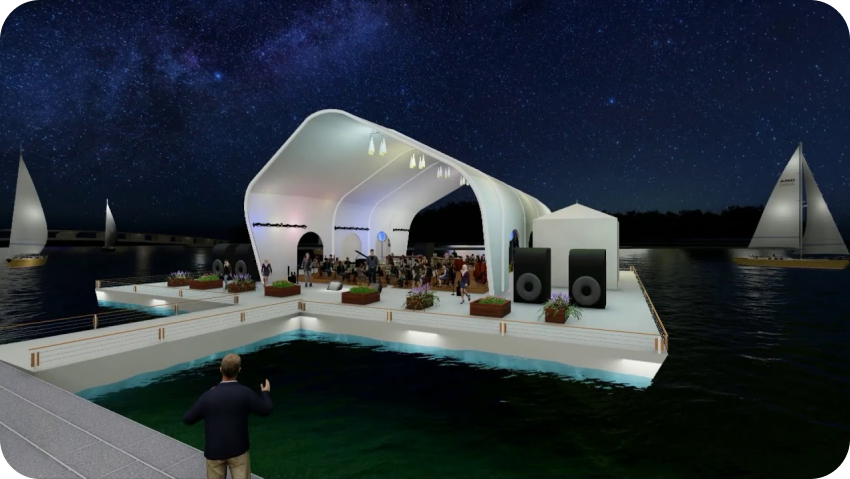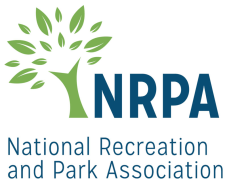Bringing the arts to the people with a floating stage at public parks offers numerous benefits:
Accessibility: It makes the arts more accessible to a wider audience, breaking down barriers to entry and allowing people from various backgrounds to enjoy cultural performances.
Community Engagement: Promotes community engagement and cohesion by providing a shared space for people to gather, connect, and enjoy artistic events together.
Enhanced Public Spaces: Transforming public parks into cultural hubs enhances the overall aesthetics and appeal of these spaces, making them more vibrant and inviting.
Cultural Enrichment: Provides opportunities for cultural enrichment, fostering an appreciation for various art forms like music, dance, theater, and visual arts.
Economic Boost: Attracts visitors, which can boost the local economy by increasing foot traffic to nearby businesses and restaurants.
Health and Well-being: Supports mental health and wellbeing by offering a space for relaxation, enjoyment, and stress relief through artistic experiences.
Educational Value: Offers educational opportunities for schools and community organizations to engage in arts education and workshops.
Fosters Local Talent: Provides a platform for local artists and performers to showcase their talents, encouraging artistic growth within the community.
Tourism: Can become a tourist attraction, drawing visitors from outside the area and contributing to tourism revenue.
Inclusivity: Encourages inclusivity and diversity in the arts, allowing for a broader range of voices and perspectives to be heard and seen.
Environmental Considerations: A floating stage can be designed with eco-friendly features, promoting sustainability and raising awareness of environmental issues.
Adaptive Use: The flexibility of a floating stage allows for a wide range of events, from concerts to theatrical performances, ensuring year-round use and adaptability to different artistic needs.
Let’s delve into more details on the benefits of bringing a floating stage to public parks for arts and cultural events:
Accessibility:
A floating stage in a public park can be strategically located to ensure easy access for all members of the community, including those with mobility challenges.
It can accommodate larger audiences compared to indoor venues, making cultural events accessible to a broader demographic.
Community Engagement:
Public parks are neutral, communal spaces where people of diverse backgrounds naturally gather, fostering a sense of community and shared experience.
Cultural events on a floating stage encourage social interaction and build a sense of belonging among attendees.
Enhanced Public Spaces:
The addition of a floating stage can transform a mundane public park into a dynamic and visually appealing cultural destination.
It may include landscape enhancements, seating areas, and artistic installations that enhance the overall ambiance.
Cultural Enrichment:
Exposure to various art forms and performances in a park setting can broaden the cultural horizons of the audience.
The diverse range of cultural events can cater to different tastes and interests within the community.
Economic Boost:
Increased foot traffic during cultural events can benefit local businesses, including food vendors, souvenir shops, and nearby restaurants.
The economic impact extends to job creation in event planning, production, and hospitality.
Health and Well-being:
Public parks with floating stages offer a natural, open-air environment that supports relaxation and reduces stress.
The arts have been shown to have therapeutic benefits, contributing to the overall mental and emotional well- being of attendees.
Educational Value:
Educational programs and workshops can be integrated into cultural events, offering opportunities for schools and community groups to learn about different art forms and cultures.
Arts education fosters creativity and critical thinking skills.
Fosters Local Talent:
Local artists and performers gain exposure and recognition, which can lead to career growth and development. A floating stage can serve as a launching pad for emerging artists, promoting a thriving local arts scene.
Tourism:
High-quality cultural events on a floating stage can attract tourists, generating revenue for the local economy through accommodations, transportation, and dining.
Inclusivity:
Efforts can be made to ensure that cultural events are inclusive, catering to diverse audiences and representing various cultures and perspectives.
Accessibility features can be integrated, such as sign language interpreters and accommodations for individuals with disabilities.
Environmental Considerations:
Eco-friendly design elements like solar-powered lighting or sustainable materials can be incorporated into the floating stage, raising awareness about environmental responsibility.
Adaptive Use:
The versatility of a floating stage allows for a year-round calendar of events, including concerts, theater productions, dance performances, and even community meetings or gatherings.
In summary, a floating stage in a public park serves as a dynamic and inclusive platform for arts and culture, offering numerous advantages that extend beyond entertainment to encompass community development, economic growth, and personal enrichment.
Let’s explore the benefits of using underutilized shorelines, lakes, and ponds for floating stages, as well as the economic advantages related to the boating and marine industry:
Benefits of Using Underutilized Shorelines, Lakes, and Ponds:
Optimal Use of Natural Resources:
Utilizing underutilized shorelines, lakes, and ponds for floating stages maximizes the use of natural resources, making use of existing bodies of water instead of creating new structures.
Scenic Backdrops:
Waterfront locations provide picturesque natural backdrops for cultural events, enhancing the overall aesthetic appeal of performances and attracting more attendees.
Sustainable Design:
Floating stages can be designed with sustainability in mind, using eco-friendly materials and technologies to minimize environmental impact.
Waterfront Revitalization:
The development of cultural venues on underutilized shorelines can kickstart waterfront revitalization projects, improving the overall attractiveness and value of the area.
Alternative Recreation:
Offers an alternative form of recreation, encouraging people to explore and appreciate natural environments while enjoying artistic performances.
Economic Benefits of the Boating and Marine Industry:
Job Creation:
The boating and marine industry generates a significant number of jobs, including boat manufacturing, maintenance, and repair, as well as marina and waterfront facility operations.
Tourism Revenue:
Boating and marine activities attract tourists, contributing to local economies through spending on boat rentals, charters, accommodations, dining, and recreational services.
Marina and Harbor Development:
The presence of a boating industry fosters the development of marinas, harbors, and related infrastructure, which can become valuable assets for a community and generate revenue.
Boat Sales and Trade:
Boat sales, both new and used, generate revenue for dealerships and manufacturers, further supporting the industry’s growth.
Supporting Industries:
The boating industry supports a wide range of auxiliary businesses, including marine equipment suppliers, yacht brokers, and boat insurance providers.
Tax Revenue:
Taxes on boat sales, mooring fees, and related services contribute to local and regional tax revenue, which can fund public services and infrastructure projects.
Recreational Opportunities:
A thriving boating and marine industry provides local residents with recreational opportunities, improving their quality of life and overall well-being.
Promotes Waterfront Tourism:
Communities with a vibrant boating scene often become attractive tourism destinations, drawing visitors who want to explore water-based activities.
Incorporating floating stages into underutilized shorelines, lakes, and ponds not only enhances the cultural landscape but also taps into the economic potential of the boating and marine industry, creating a synergy that benefits both the arts and the local economy.







